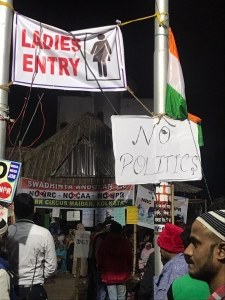 The women are sitting with hijabs and scarves over their heads. They are huddled in coats and blankets against the harsh winter nights of Delhi, Allahabad and Lucknow where the temperature is sinking to 3 degrees Centrigrade. They sit there silently all night listening to speeches, ringed round by a protective circle of men in many cases in case the police arrive with batons. What the women are doing is illegal – they are protesting against the Citizenship (Amendment) Act and the National Register of Citizenship declared in a sudden swoop by the Government of India and passed in the upper house in December. The CAA provided for citizenship to Hindus, Sikhs, Jains, Buddhists, Christians and Parsis from Pakistan, Afghanistan and Bangladesh Indian citizenship. The NRC would require every India to prove his/her citizenship. Together the two would filter out Muslims.
The women are sitting with hijabs and scarves over their heads. They are huddled in coats and blankets against the harsh winter nights of Delhi, Allahabad and Lucknow where the temperature is sinking to 3 degrees Centrigrade. They sit there silently all night listening to speeches, ringed round by a protective circle of men in many cases in case the police arrive with batons. What the women are doing is illegal – they are protesting against the Citizenship (Amendment) Act and the National Register of Citizenship declared in a sudden swoop by the Government of India and passed in the upper house in December. The CAA provided for citizenship to Hindus, Sikhs, Jains, Buddhists, Christians and Parsis from Pakistan, Afghanistan and Bangladesh Indian citizenship. The NRC would require every India to prove his/her citizenship. Together the two would filter out Muslims.
The NRC chaos began in Assam where thousands who could not prove their citizenship were herded into detention camps. Behind this of course is the fact that the Muslims who elected to stay in India when the country was Partitioned in 1945 had no certificates to prove their nationality since they had been long time residents of what was then Hindustan.
Murmurs of protest began once the law was passed with the usual accepted marches. However, then the grammar of protest was suddenly redefined in Shaheen Bagh.
The protest in Delhi’s Shaheen Bagh has become an enduring symbol of the demonstrations that have swept India over the new law, which was passed in December. Shaheen Bagh started after the police raided JNU and assaulted protesting student who happened to be unarmed. It began with four women and six men but gradually more joined while the men went to work. No leader was identified, in fact the women declared that theirs was a universal protest. The Shaheen Bagh model was then followed in other parts of the country. There are men but they restrict their roles to those of protectors going to work in the mornings while the women remain sitting. Children spend the night with their mothers and go to school, returning again later to do their homework. Volunteers provide food.
The Shaheen Bagh sit in has continued for a month. Prime Minister Modi has been invited to hear women out over tea but so far has declined. Lucknow, Allahabad and Kolkata have added to the ranks of sit outs. Amit Shah has also been invited to address the women at his Lucknow rally so they can understand his policies better but he too has declined.
Women have always formed part of protests and movements since the time of independence – they joined Mahatma Gandhi’s non-violence marches. Women also hugged trees all night to prevent them being cut down in the Chipko Movement in 1973. There were names that became prominent in these movements – in Shaheen Bagh and the other sit outs the leaders are anonymous. The women are together in their protest because they know that their households and lives will be disrupted by CAA and NRC.
Many come to share their problems – a girl confessed that her political and personal lives were conflicting because she studied with RSS and BJP students many of whom were her friends and the women listened patiently to her telling the men who were shouting slogans to shut up and listen. It is domestic at one level, women united by a common problem and willing to sit it out, patiently enduring till the chaos is put to rights and helping others to comprehend and reach a solution without violence or sloganeering.
What alarms the BJP Government is the fact that the movement proves that Muslim women are not relegated to the closeted interiors of their homes. They have a voice of their own and despite measures like the triple talaq bill which the Government claimed was designed to empower them they have come out to protest of their own accord. Shaheen Bagh and its clones have brought together women of all ages ranging from fiery college students, placid homemaking mothers to sedate grandmothers.


